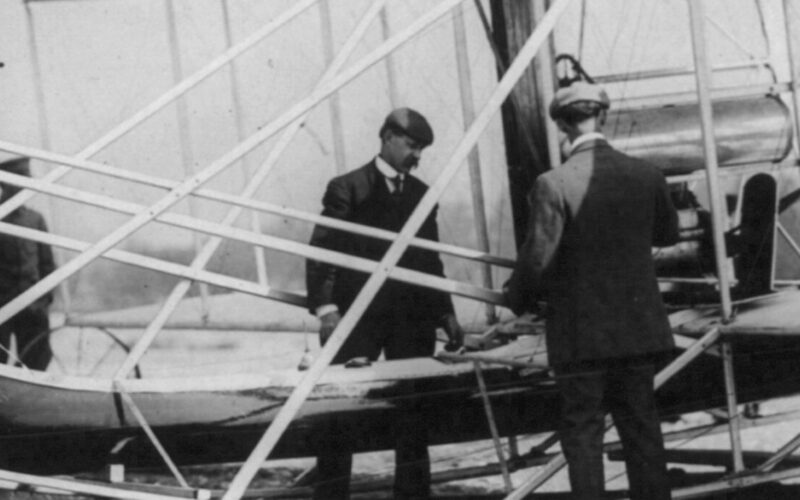There are a number of famous people who spring to mind when we think of aviation pioneers. The Wright Brothers, Amelia Earhart, Charles Lindbergh and Bessie Coleman to name just a few. But what do we know about the highly skilled people who helped these famous flights get off the ground?
One such person whose name seems to have been largely overlooked is Charles E. Taylor, the world’s first aviation technician.
Charles ‘Charlie’ Taylor was born in 1868, just a few short years before Jules Verne’s novel “From the Earth to the Moon” was published, which depicted the use of a cannon, or “space gun”, as an efficient and realistic means of air travel. At the time, a liquid-powered internal combustion engine had not yet been patented, and it would be almost half a century before the first controlled, powered flight took place.
The first third of Taylor’s life took place during the 19th century, a period characterized by early, sometimes misguided, and often downright wacky attempts at aviation. But his last years were spent during the jet age.
Taylor died in 1956, aged 87. It was little more than a year before the first artificial satellite was launched into orbit. The de Havilland Comet, the world’s first jet airliner, was due to resume its service following a series of crashes, and the Boeing 707 has just entered production. The first supersonic jets were put into military use around the world, and there was a great deal of talk about upcoming supersonic passenger airplanes.
Many aviation pioneers witnessed similar change during their lifetimes – and Taylor was at the center of this period of innovation.
The mechanic and the engine
By today’s definition, Taylor can be considered as the world’s first maintenance, repair, and operations (MRO) technician, although the term did not exist back when he began his career.
Taylor started work as a tool maker at a young age, and eventually ended up at a workshop in a building owned by the uncle of his wife, Henrietta Webbert.
By sheer coincidence, it was the same building where Orville and Wilbur Wright’s bicycle workshop was located. Taylor went to work for the Wright brothers and, as the siblings began to experiment with flying machines, Taylor was drawn into their aeronautical pursuits.
While working with gliders, the Wrights began to dream of something more substantial, a device that could fly under its own power and carry a human in the process. While engineers from across the world had been attempting to achieve the very same thing for many years, not one had managed to succeed in the task.
The lack of a suitable engine was the root of the problem. The powerplant had to be very light and powerful (at least by late 19th century standards) and needed to fit onto an airframe made of canvas and wood. It would then need to propel that airframe, which was not aerodynamic, as the science of aerodynamics was only in its infancy, to a speed which (again, by 19th century standards), was unusually fast.
While many early aviators battled this problem, they were faced with failure, as an engine like this was not commercially available at the time. So, the Wrights approached Taylor and asked him to build one.
Forgetting and remembering
The Wrights needed an engine with at least 8 horsepower (6.0 kW). Taylor’s engine achieved 12 horsepower (on par with a modern low-end dirt bike engine) and weighed 82 kilograms (180 pounds, comparable with an average whole dirt bike). But for that time, it was a technological marvel, and allowed the world’s first proper airplane to take flight.
Since that historical achievement, Taylor became an indispensable part of every flight demonstration made by the Wright brothers. He went on to follow the original Wright Flyer, as well as its upgraded developments, across the US, ensuring that the aircraft worked as intended.
Surprisingly, Taylor never flew himself. But if not for him, the Wrights’ challenges with powered flights might have been insurmountable – and they may have never gotten off the ground.
Taylor retired in the 1920s and entered the real estate business. However, he was unsuccessful, and the enterprise cost him his life savings, plunging him into poverty.
In the 1940s a serious health condition prevented Taylor from working as a mechanic and after spending a decade being treated in various hospitals, he died.
Legacy and recognition
For much of his life, Taylor remained relatively unknown and received little attention until gaining some recognition in his final years.
The work of modern-day aircraft mechanic is similar to Taylor’s in that few notice when it is done well, as the spotlight tends to be focused on flight crew and the aircraft itself.
Taylor’s resting place is the Portal of the Folded Wings Shrine to Aviation in Los Angeles, where he lies amongst a host of other, far better-known aviation pioneers. May 24 – his birthday – is celebrated as Aviation Maintenance Technician Day, the most visible manifestation of Taylor’s legacy. But his true legacy is evidenced by the aviation industry, which would not exist as we know it today without his efforts.

